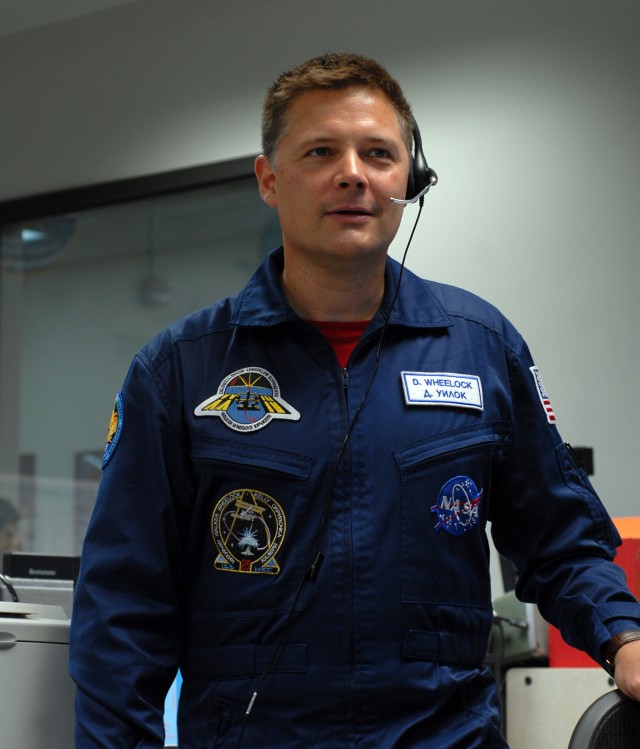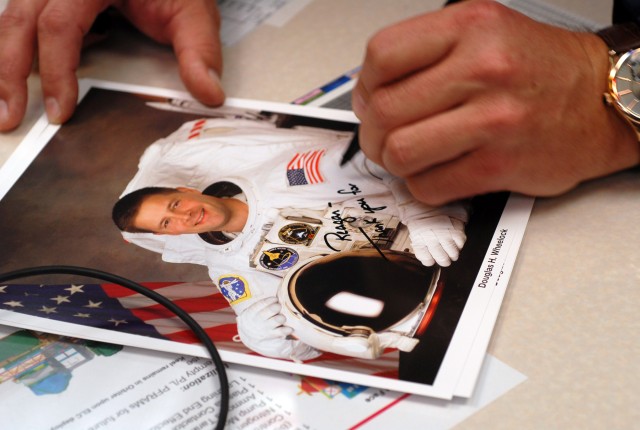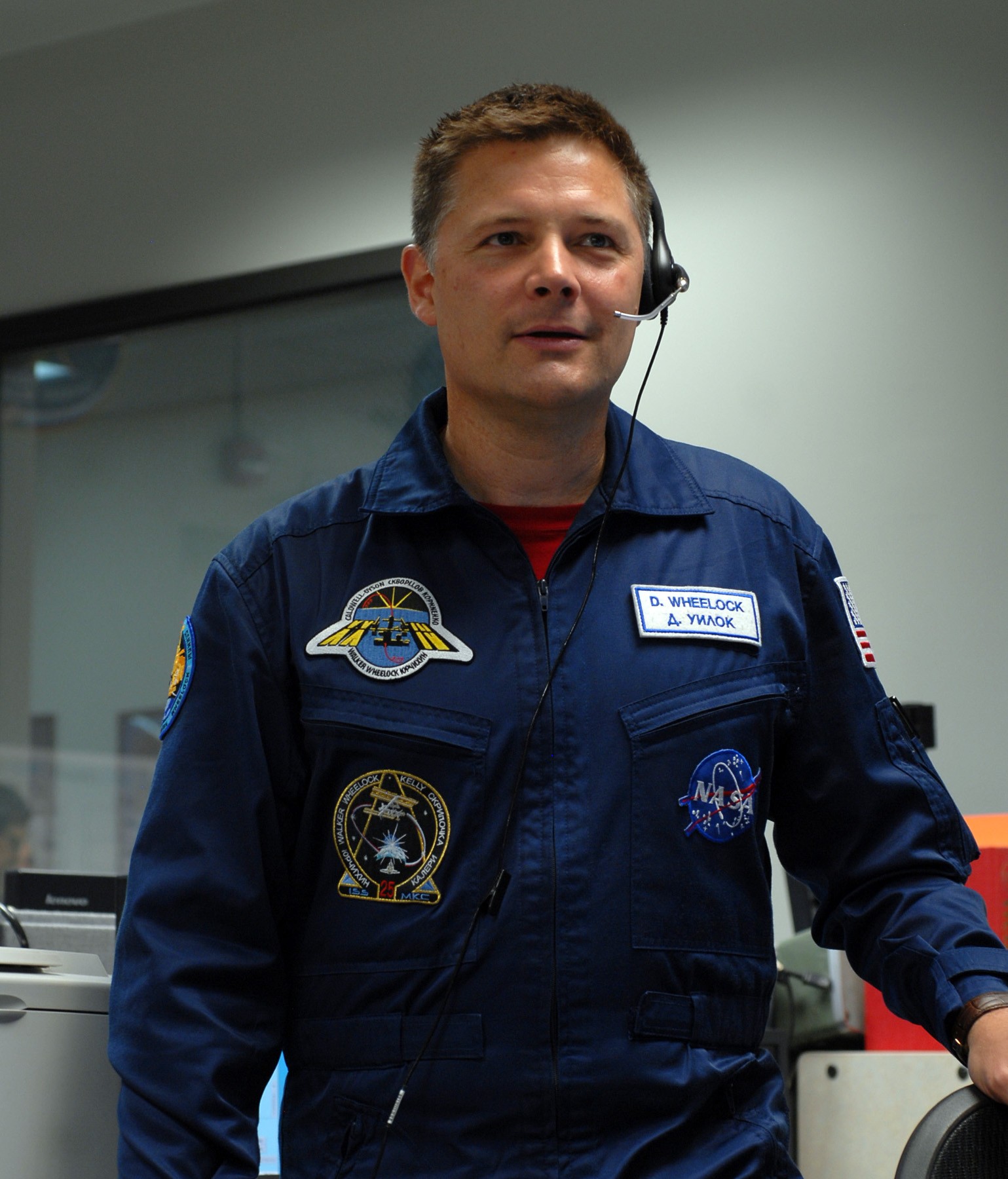REDSTONE ARSENAL, Ala.--Col. Doug Wheelock's six-month deployment to the International Space Station has ended with a down-to-earth mission.
This Army astronaut now has both feet planted firmly on the ground, taking the time to personally thank Marshall Space Flight Center employees, and to share his excitement about space and its possibilities with school children throughout Alabama. He visited Redstone Arsenal on April 11.
"This is where it all happens," said Wheelock as he entered the viewing room of Marshall's Payload Operations Center in building 4663.
"This is very exciting for me to come to Huntsville, and to share my thanks for a fun-filled adventure on the International Space Station ... I am thrilled to be here to meet with ground controllers ... I am so excited to talk about the adventures of a full operating science platform."
Wheelock, a 29-year Army veteran and dual-rated Master Army Aviator assigned to the Space and Missile Defense Command/Army Forces Strategic Command, is the first active-duty Army astronaut to command the International Space Station. He launched to the space station June 15, 2010 in a Russian Soyuz spacecraft. During his 163 days aboard the space station, Wheelock was a mission specialist and then took over command of the Expedition 25 crew in September with the departure of the Expedition 23/24 crew. He participated in spacewalks during which the orbiting modules were completed and brought into full use.
Wheelock and the other five crewmembers were responsible for more than 120 microgravity experiments in human research; biology and biotechnology; physical and materials sciences; technology development; and Earth and space sciences.
But Wheelock is best known to school children and the general public for Twitter feeds of his photos that captured the majestic beauty of Earth from the space station, and for the work he did to save the space station when half of its external cooling system shut down due to a faulty ammonia pump module. Wheelock participated in three unplanned spacewalks to replace the pump module. He and two fellow crewmembers returned to Earth on Nov. 25, 2010 in a Russian Soyuz spacecraft.
Astronauts usually visit Marshall after their missions to thank the employees at the Payload Operations Center for their support of the scientific accomplishments made in space. But Wheelock took his visit to Marshall personally.
"I've been in military service for 29 years, and never in my life have I seen teamwork like we experienced with our team here in Huntsville. It's pretty incredible," Wheelock said of the employees of the Payload Operations Center during a press conference.
"This is an emotional day for me. How do you thank someone who kept you alive in a dying space ship' Mission control in Houston may be a little jealous, but we talked to mission control in Huntsville more than we did with Houston because of science experiments running through this control center. We said 'hello' a thousand times from space."
The teamwork and character of the employees of the Payload Operations Center had a tremendous impact on the space station crew "when the space station kind of died on us. We lost half our power and half of our science," Wheelock said.
"We worked incredibly hard with Huntsville to save parts of the experiments that had to stay in deep freeze. We were shut down (partly) for three weeks until we got the pump repaired ... People say adversity builds character. I think adversity really exposes character. In the July/August time frame what happened really exposed the character of this incredible team. They kept us alive and they kept science platforms going. They kept us on the primary task of this orbiting laboratory."
During the press conference, Wheelock touched on the end of the space shuttle program, which has only two missions left before its fleet is retired.
"The shuttle has been a workhorse for us," he said. "This is a sad time. My whole adult life, the space shuttle has been the backbone and workhorse of the whole space program.
"We are now seeing the return on investment in science. With 135 experiments on board, the space station is taking center stage. We are finding new discoveries in the medical field and better ways to take care of the environment. We are also learning how to build a space ship to go somewhere else like to the moon or Mars, and what we need in terms of regenerative life support systems."
The space shuttle and space station have taught scientists a lot about flying vehicles in "very, very harsh environments" and the effect on metals and materials when they are "exposed to increased levels of radiation and incredible temperature swings," he said. "We have measured 500 temperature swings in 45 minutes. We have gained a tremendous amount of information in the engineering field."
Though science takes up a lot of crew time, the space station crew is also busy putting together life support systems inside the space station, learning how to build structures in orbit and managing "surprises around every corner."
Besides the pump failure, those surprises during Wheelock's time in space included the near collision of the space station with the Russian Progress unmanned vehicle, which was bringing supplies to the station. The incident complicated and delayed the vehicle's docking procedure.
During his visit to Marshall, Wheelock, who goes by the nicknames "Wheels" and "Cupcake" within the astronaut corps, shared humorous anecdotes from his mission with employees of the Payload Operations Center.
He described for them the scary moments during six spacewalks and during the seven hours following the pump failure when "we were turning off alarms and trying to figure out what happened to the space station." He told them about the beauty of the views of Earth - including the Himalayan Mountains, the Australian Outback, Niagara Falls, Pearl Harbor and the Great Barrier Reef -- from the space station as it orbited the Earth every 90 minutes, and the violence of his return aboard the Soyuz capsule, which he called an "incredible ride home" on a "little charcoal briquette."
His multi-day trip to Alabama also included visits with about 5,000 students and stops at the U.S. Space & Rocket Center and at schools in Boaz, Birmingham, Montgomery and Houston County that have participated in the Civil Air Patrol's K-6 Aerospace Connections in Education Program.
"Before I launched on this mission, my goal was to make space real for kids, to share with them the joy and story of space," Wheelock said. "I take that as my challenge. I want to make it as real as possible for them and Twitter was a part of that. We are in a period of transition with a lot of unknowns. But we still have a very, very vibrant space station and still some incredible things to come with this orbiting world-class science platform."
Wheelock's space station deployment wasn't his first trip into space. In 2007, he flew on a 15-day space shuttle mission to the space station, during which he accumulated 20 hours and 41 minutes on three spacewalks to attach a module to the space station that opened up the capability for future international laboratories to be added to the station. He also participated in an unplanned spacewalk to repair a damaged solar array.
As a Master Army Aviator, Wheelock has logged more than 3,000 flight hours in 45 different rotary and fixed-wing aircraft and spacecraft. His Army training taught him about leadership and teamwork within small units.
"The Army places a fairly heavy weight on leadership as does NASA," he said. "The Army taught me the strength of a small unit, and on the space station we had a unit of six on board along with the teams on the ground ... You learn about yourself and your leadership style in the military as well as about other leadership styles."
During his visit at Marshall, Wheelock signed the Expedition 25 emblem that was then hung in the Payload Operations Center by increment lead operations controller Damon Self.
"It's hard to find words for people that kept you alive for six months," he told the Marshall employees in the operations center. "It was just incredible working with you guys. The whole experience was life changing for me because of you guys."
Wheelock also spoke to the crew of the International Space Station during an impromptu call-up by payload communicator Reagan Malone. He shared a few jokes with crewmember European Space Agency astronaut Paolo Nespoli, who is with Expedition 27, and then added his own advice.
"Don't let a day go by without looking out those windows," Wheelock told Nespoli over the headset. "Of the 163 days I was there, there were three or four days I didn't get to a window and those are the days I regret."




Social Sharing